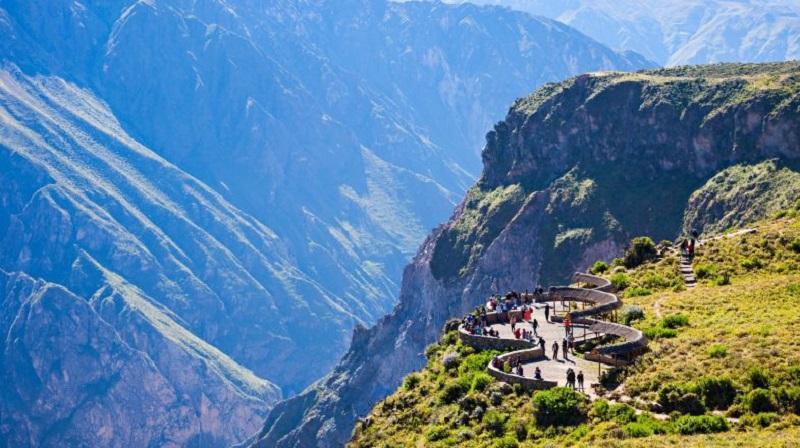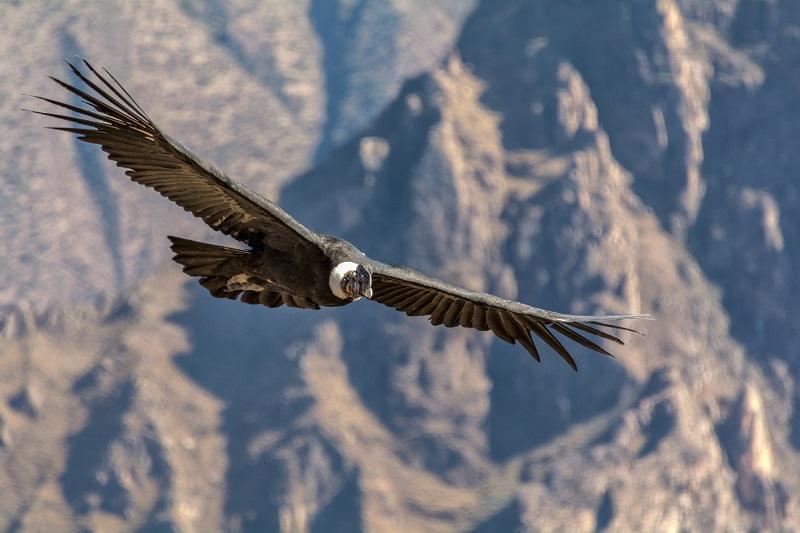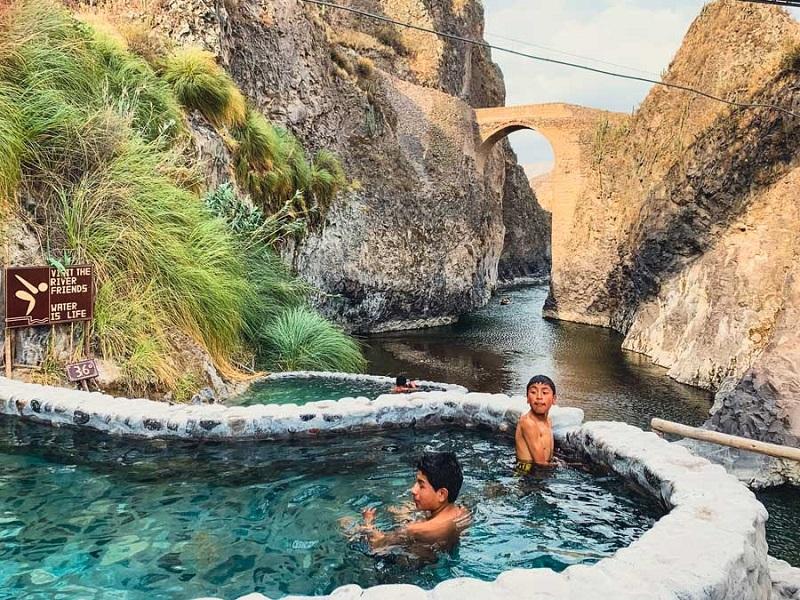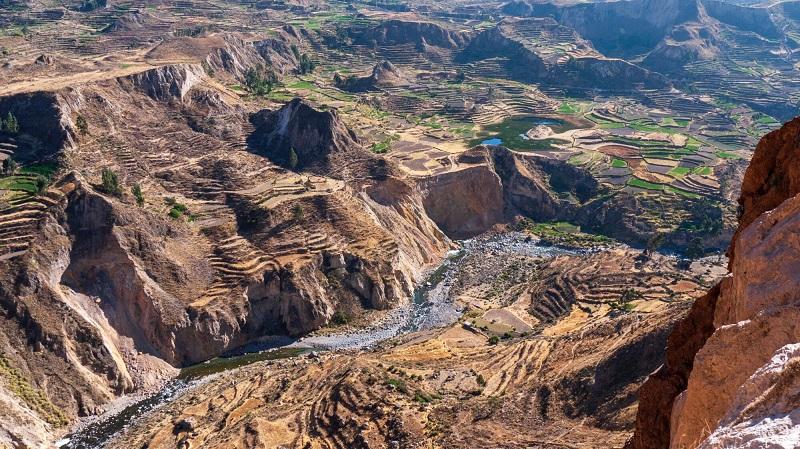Colca Canyon is a must-see geological wonder in the Colca Valley of Peru’s Andes. It is one of the deepest canyons globally and the second in Peru after Cotahuasi Canyon. With its depth ranging from 3300 to 6600 feet and stretching 70 kilometres, the Canyon’s magnificence is best appreciated at Cruz del Condor. This viewpoint offers a stunning perspective on the Canyon’s depth throughout the year.
Situated approximately 160 kilometres northwest of Arequipa, the Colca Canyon can be reached by a four-hour bus ride to Chivay, the starting point of the Canyon. The valley surrounding the Canyon is a vibrant hub of indigenous culture, featuring rich traditions like the Inca and pre-Inca irrigation systems and terraced agriculture known as Andenes.
Visitors can immerse themselves in this cultural experience, explore high-quality handicrafts, and indulge in various adventurous activities. In 1981, a group of Polish adventurers and kayakers led by Andrzej Pietowski brought global attention to the Colca Canyon, proclaiming it possibly the world’s deepest. Their descent from the Canyon, documented in the book “Kayak Through Peru” and a water guide, earned it a place in the Guinness Book of Records as the deepest Canyon in 1984.
However, it wasn’t until the early 1990s when National Geographic published an article reinforcing this claim that tourism in the area began to surge. Since then, the Colca Canyon has become Peru’s third most visited tourist destination, attracting visitors with its natural splendour and cultural significance.
How to get to the Colca Canyon?

The drive from Arequipa to Chivay is about three hours by car or longer by bus. Buses usually go from Arequipa to Chivay, but checking if the service extends further to Cabanconde is recommended.
On the way from Arequipa to Colca, you pass through highland landscapes and the Salinas and Aguada Blanca National Reserve. You can see herds of vicuñas, volcanoes, and stunning high-altitude landscapes along the road at Patapampa Pass.
Weather in the region
Colca Canyon weather follows the typical Andean pattern in Peru. It has a rainy summer (January to March) and a dry winter (May to November), with transitional periods in between.
During the wet season, expect cloudy skies, brief downpours, and the highest rainfall in February. Daytime temperatures average around 60°F (16°C), dropping to 45°F (7°C) at night.
From May to November, the region enjoys primarily sunny conditions with minimal precipitation in the dry season. Daytime temperatures hover around 65°F (18°C), potentially rising even higher under direct sunlight. At night, with clear skies, temperatures can drop to a chilly 25°F (4°C).
Elevation influences temperatures. Lower parts of the Canyon can be warm during the dry season, especially on exposed hiking trails. As you ascend, temperatures become colder and windier. Mornings and evenings are generally chilly, particularly in the dry season.
What to do at Colca Canyon
Andean Condors

Colca Canyon offers exceptional opportunities to observe condors up close in South America. Mirador Cruz del Condor, a viewing platform, captures the enchantment of the towering Andes. The majestic mountains soar above while the valley floor plunges into dizzying depths below. With luck, you can witness Andean condors gracefully soaring on the thermal updrafts created within the Canyon, eliciting awe from mesmerized spectators.
Condors are revered in Andean folklore and mythology across Latin America. They are regarded as spiritual creatures by the Inca, embodying the essence of the spirit world. Witness their majestic flight and delve deeper into their significance in Peru.
Visit the planetarium
Look up at the sparkling night sky above Colca Canyon. In Chivay, Casa Andina Standard offers nightly tours in English and Spanish at their small planetarium and observatory. Note that the planetarium is usually closed from January to March due to cloudy conditions during the rainy season in Colca. Discover Inca astronomy and the southern night sky.
Chivay
Chivay, located at 11,800 ft (3,600 m) on the banks of the Colca River, is the central tourism hub of Colca. It connects the two sides of Colca Canyon and is crucial to the region’s environmental and ecological economy. Agriculture thrives below this elevation, while livestock and ranching dominate the higher highland economies.
In Chivay, you’ll find a wide range of lodging options, a vibrant market in the plaza, and shops that offer excellent local handicrafts. Just a short stroll from the town, you can relax in the hot springs of La Calera, perfect for unwinding after a day of exploration.
Enjoy the region’s hot springs

Relax and rejuvenate in the hot springs and geysers of Colca Canyon. Whether in Chivay or just finished a trek, these natural pools offer curative properties, especially for rheumatism and arthritis.
La Calera hot springs, located 2 mi (3.5 km) from Chivay, provide indoor and outdoor pools with different temperatures and stunning mountain views. For a more tranquil experience, visiting early in the day is recommended, as afternoons can be livelier.
Chacapi hot springs, situated 1 mi (1.5 km) from Yanque’s plaza, offer a pleasant setting to unwind in thermal waters after a day of exploration. The pool temperatures can reach up to 122°F (50°C). And if you’re staying at Colca Lodge, you’ll enjoy unlimited access to their exceptional thermal pools.
Visit nearby Cabanaconde
Cabanaconde is the nearest town to Mirador Cruz del Condor and the starting point for treks to Sangalle. It’s ideal for travellers seeking day hikes, with remarkable lookout points nearby. From Cejana, San Miguel, and Achachiwa trail viewpoints, you can glimpse villages in the valley below and be awed by the majestic mountains across the Canyon. You might even spot condors gliding overhead.
Conclusion
Visiting Colca Canyon is an awe-inspiring experience that offers breathtaking natural beauty, rich cultural heritage, and a chance to connect with the remarkable ecosystem of the Andean region. As one of the world’s deepest canyons, it presents a remarkable display of towering cliffs, lush valleys, and dramatic landscapes that leave visitors in awe of nature’s grandeur.
The Canyon’s diverse flora and fauna, including the majestic Andean condors soaring above, add to its allure. Witnessing these magnificent creatures in their natural habitat is a rare and unforgettable sight, making Colca Canyon a popular destination for birdwatchers and wildlife enthusiasts.



